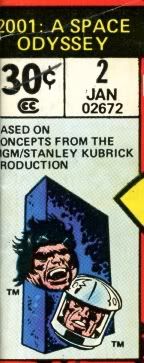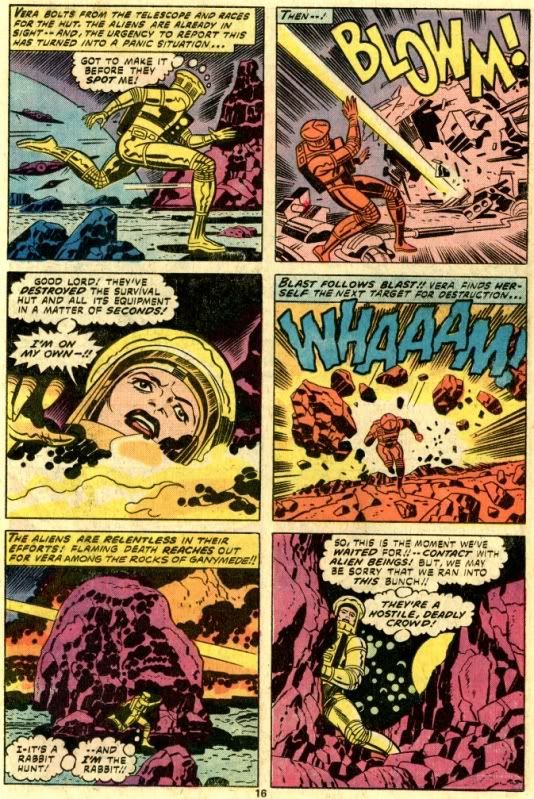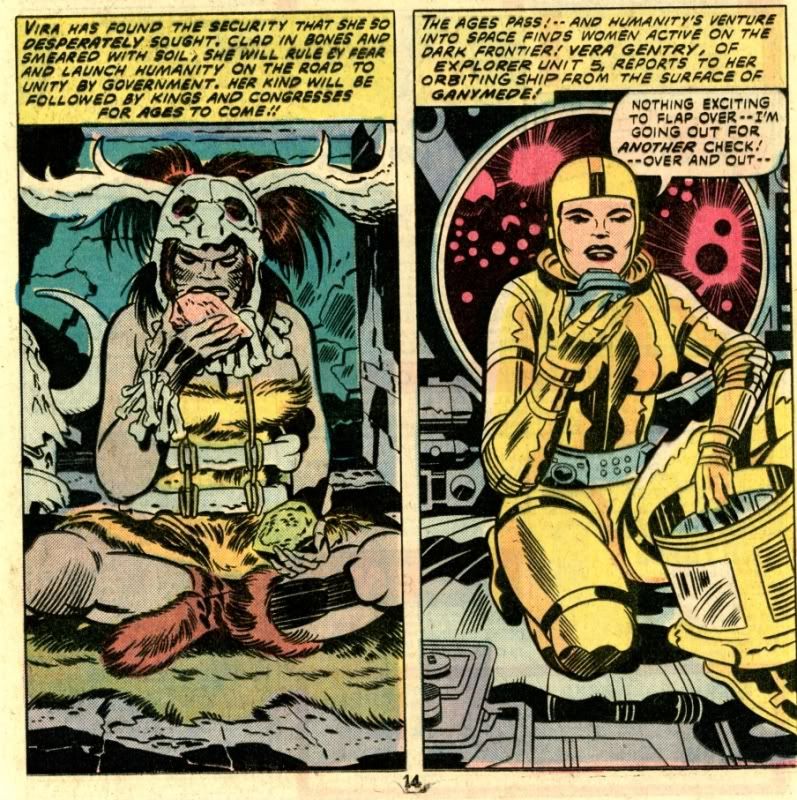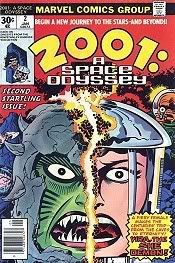Writer, Artist, Editor: Jack Kirby
Marvel Comics, 1977.
(This review originally appeared at Weird Crime Theater.)
By pure coincidence, I found this comic at the Camberwell Collector’s Fair the very same week that I was reading Arthur C. Clarke’s novel version.
A cursory glance at the cover will tell you that Marvel’s approach to this property was so divorced from that of Stanley Kubrick or Clarke as to make it effectively unrecognizable. I mean, just look the price box alone!

I don’t know what the fuck Marvel thought they were doing when they decided to license this book 8 years after the movie came out and they knew full well how un-Marvel (i.e. cerebral) it was. Even then — why give it to Kirby of all people?!?
I imagine if you bought this comic as a fan of the book or the movie, you would have been thoroughly disgusted. Although, as a Kirby comic in itself, you can’t help but be completely pummeled and pulped and exhausted by the end of it, like all of Kirby’s best work.
Kirby’s sensibilities are the polar opposite of those of Kubrick / Clarke. Their version of 2001 was about sterility and boredom. Jack’s version is colorful, emotionally deafening, and bombastic. As usual, characters and their surroundings feel almost too big to fit in the panels. Can you imagine the sequence below in the movie?


Also, for example, Kubrick would show you the effects of gravity and let you work out for yourself why it is the way it is. Clarke would describe it in a scientifically fascinating way. Kirby completely ignores its existence. His character lands on Ganymede — a moon of Jupiter — and, except for wearing a spacesuit, she goes about her business as if she were on Earth. It’s pure comic book ludicrousness if you’ve experienced the book or movie first. Getting to Ganymede in the first place would be a monumental undertaking in the novel.
And yet, despite all this, there are some disconcerting similarities to the original property. Issue #1 was apparently an adaptation of the movie — I haven’t read it. And what are you going to do with number 2, except basically the movie / book all over again, except with a female lead and Jack Kirby style? A cave woman, threatened with starvation, fights off some enemies using a skull on a stick, then runs into a cave where she encounters a monolith, which imbues her with knowledge which allows her to become a queen. Cut to the future showing a similar woman in almost the same pose — just like the bone-to-spaceship jump in the movie. She lands on Ganymede, a moon of Jupiter, is attacked by vicious aliens, escapes and encounters a monolith. She enters the monolith, has surreal visions of kaleidoscopic lights (in a great sequence that is just what you hope for from Kirby, and then relives her whole life on earth and grows old before she is transformed into a space baby.

Except for the alien nonsense, this is pretty much what you get in the book and movie. Which is why it’s so disorienting to see basically the same plot interpreted by Kirby in 20-odd pages. In fact you need to have some prior knowledge about the Monolith premise before the story can really be understood. But while the original property was concerned with sterility and monotony to some extent, it was also — and this is the chief point — often about awe and wonder. And this is conspicuously absent in the comic where Kirby goes back to his usual toolbox of fisticuffs and legs akimbo six feet apart. I would find that a little bit disappointing, if it weren’t for it being such a great toolbox in itself.
Somehow, Kirby (who edits himself, much like Steve Gerber did on Howard the Duck) knew how to make 2001 into a Marvel comic, which probably answers my earlier question about why Marvel would even touch the property. Still, the series only lasted ten issues, which suggests to me that they did not connect with fans of the movie because of the obvious “liberties” they took. Why they didn’t connect with Marvel fans, I don’t know, ‘cause this is a great comic for what it is despite all I’ve written. I mean the art is beautiful and the story is psychedelic. (The reproduction is pretty poor though, as was typical of the era. And unlike the rest of Kirby’s catalog, it’s hard to imagine this series getting reprinted.)
One last, important note. The next issue box advertises a “two-part look at the next candidate for the new seed,” which seems to suggest that each issue, candidates are going to be chosen to become “space seeds,” as if they have to somehow prove themselves worthy. But in the movie the viewer has to really question whether man (or the apes) has done anything to actually deserve the evolutionary gift bestowed on it. The comics suggests they’re handing them out like Green Lantern rings, which — to me — was a more jarring (and childish oversimplifying) diversion from the original than Kirby’s radical visuals.
KS
————————————————————————————-
Kumar Sivasubramanian is the writer of Weird Crime Theater.


I remember reading one of these Kirby 2001 adaptions. While I love Jack Kirby stories, I was disappointed in the story I read because it was so different from the movie. I did enjoy the art, but that was about it.
Kumar, Reading these pages with your thought “Can you imagine the sequence below in the movie?” had me cracking up! Totally antithetical to the tone of “2001”!